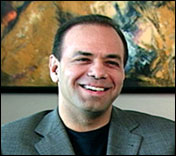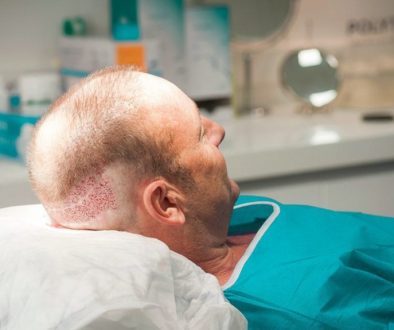Dr. James Harris Shares His Experience with the ARTAS Follicular Unit Extraction System
Recommended hair transplant surgeon Dr. James Harris has always been a follicular unit excision (FUE) pioneer. In 2004, his S.A.F.E. FUE extraction tool greatly decreased transection rates and increased the prevalence of FUE by introducing the “blunt tip” punch; in 2009, he presented his motorized S.A.F.E. FUE Power Scribe – the first motorized follicular unit excision (formerly follicular unit extraction) tool to greatly reduce transection rates while simultaneously increasing extraction speeds; and in 2011, his work with Restoration Robotics helped give rise to the ARTAS follicular unit excision system.
Because of Dr. Harris’ extensive FUE expertise and experience with the ARTAS FUE system, we asked him to share his impression of the device. Curious as to what Dr. Harris likes about the ARTAS system? Wondering if he believes the device falls short in any crucial categories? Want to know what he thinks about “neophyte” surgeons using the machine? Read Dr. Harris’ input on the ARTAS Hair Restoration System below:
The ARTAS System Experience
James A. Harris, MD, FACS
 The ARTAS System was in development for approximately seven years and during that time it went from a concept to a sophisticated device for assisting physicians in performing FUE. I have personally used the device in approximately 200 procedures and I’m able to compare it to my 9 1/2 years of experience in performing FUE with the SAFE System.
The ARTAS System was in development for approximately seven years and during that time it went from a concept to a sophisticated device for assisting physicians in performing FUE. I have personally used the device in approximately 200 procedures and I’m able to compare it to my 9 1/2 years of experience in performing FUE with the SAFE System.
I have found the System to be highly accurate in assessing the follicular unit configuration and by that I mean densities, angles and directions. I have also found the system to be reliable and easy to learn, however because I was part of the development team I had years to learn the system so the experience may be different for physicians new to the system. The system is flexible enough to allow the physician ultimate control over which follicular units to extract or it can make suggestions based on a physician’s input regarding extraction density or dissection site spacing parameters.
The ARTAS System is not quite as efficient as compared to cases in which I use the SAFE System due to some inherent logistic requirements. The two most significant reasons for this are the need to move a skin tension device that holds the markings that the robot “reads” and the fact that not all of the grafts can be removed from the scalp while the dissection process is actually being performed. The robot will dissect grafts at about 1000 follicular units/hour but when the time for moving the skin tension device is factored in, the effective rate is closer to the range of 500-600 grafts/hour. When I compare the average SAFE System rates of effective graft production of 700-900/hour there is a noticeable difference in efficiency.
The cost of this technology also has to be absorbed somewhere and it may be a borne by both the physician and the patient. FUE procedures are usually more expensive and when a technology such as the ARTAS System is utilized there should be some advantage, and there are.
For the average physician starting FUE the learning curve is steep meaning that within a very short period of time the surgeon will become proficient and efficient. Most importantly however the grafts that will be produced will be excellent and that’s what matters to the patient.
My experience concerning clinical results with the ARTAS is that there has not been a single case of failure or suboptimal graft growth. I attribute this to several factors. The first is that the dull punch dissection system minimizes the transection rates comparable to strip harvest techniques meaning there is a minimal follicle wastage component. The second factor is that the dull punch dissection technique allows for dissection of the units to at least a depth of 4mm which is almost the entire depth of the unit. What this means is that with a more complete dissection there is less force required to remove the graft, therefore less trauma and an improved chance of graft survival. Finally the design of the dissection system has allowed for 75-90% of the grafts to have an amount of fat around the follicles that is comparable to strip harvested grafts. There is ample support in this field that “fatter” or “chubbier” grafts have a better survival. It is for these reasons that I believe the ARTAS System is providing a significant advancement in the field of hair restoration.
The integration into my office has not been without some challenges because the demand for FUE has increased. Although my existing team is trained in strip and FUE harvest, as well as cross-trained in the robotic FUE, I have had to add staff to keep up with the demand. Not wanting to go through the process of training a team to be proficient at cutting strip harvested grafts I have now trained an entirely new team that is specifically trained for robotic FUE surgery. The learning curve is much shorter and learning the technology is an exciting intellectual exercise.
I feel that for patients the ARTAS System is a significant advancement in the field as it provides consistent, high quality results within the expertise of the hair restoration surgeon. That is, the system provides the grafts, and it is up to the surgeon to create and execute the surgical plan to provide the natural results and it is still up to the patient to find the right physician.
The company providing the ARTAS System, Restoration Robotics, is committed to a high level of support and advancement of the technology. I am involved with the company to optimize the system efficiency and to develop enhancements that will aid in treatment planning and well as help the physician in the other steps of hair restoration surgery. With the knowledge and the expertise of the engineers of Restoration Robotics the evolution of this technology will be exciting to watch.
___________
Blake – aka Future_HT_Doc
Editorial Assistant and Forum Co-Moderator for the Hair Transplant Network, the Hair Loss Learning Center, the Hair Loss Q&A Blog, and the Hair Restoration Forum
Follow our community on Twitter
Watch hair transplant videos on YouTube
Technorati Tags: hair transplant, James Harris, follicular unit excision, FUE, S.A.F.E. FUE, S.A.F.E. FUE, ARTAS, ARTAS FUE, ARTAS Hair Restoration System



